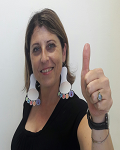
Gila Lavy
Assaf HaRofeh Medical Center, Israel
Title: An innovative way of training diabetic patients prevention and management of diabetic foot with the use of a humorous video clip
Biography
Biography: Gila Lavy
Abstract
Backround:
Diabetes has been declared by the WHO as a world epidemic. One of the most common complications of diabetes is diabetic foot, which can include infections, diabetic neuropathy, ulcers of the foot and osteomyelitis which may lead to amputation. It is estimated that a quarter of diabetic patients will develop diabetic ulcers during their lifetime, and that between six to eight of 1000 diabetics every year will experience an amputation of the foot or a part of it. Complications of the diabetic foot can be prevented in approximately 85% of cases with proper training and care. Unfortunately, even when the standard guidelines by the medical staff are provided, more than 65% of patients will develop various complications of the diabetic foot. Research on training strategies have proven that a method which appeals to the multisensory aspects of the individual, is more effective in the teaching and learning process of understanding, absorption and internalization of the material provided.
Project Objective:
The project objective is- building a creative and experiential training process and technique to teach the guidelines of maintaining healthy feet and preventing the diabetic foot. The training process should appeal to a diverse audience and engage the patient in a multisensory method: an educating video clip by combining a musical show, and lecture.
Method:
First, the musical clip was written and composed including video presentation and choreography by a clinical nurse who specializes in diabetes, as well as volunteering as a medical clown. Through her expertise and experience, special attention was given to the learning content that was provided in the video clip.
The medical clowns were selected, due to their approach to various types of populations, and their success in communicating through verbal as well as non-verbal communication. In the video clip, the medical clowns appeal effectively to their audience in all languages and to all ages. By the use of humor, which is known to eliminate barriers and antagonism, an experiential training process was created, which encouraged patients to adopt the "rules" of care. The clip was pretested with a number of diabetic patients to assess their reaction to the clip, and to ascertain that all the messages in the health clip were clearly communicated.
In the present, as a motivational strategy for diabetic patients, the clip is screened in the waiting rooms of diabetic clinics and diabetic foot clinics.
It is well known that in Israel there are many types of populations and cultures. In order to reach as many diabetic patients as possible, and with the knowledge that humor is considered a universal language, the clip has been translated into several languages. Our future plan, is to make the Diabetic Foot Clip available to all Medical Centers, and to incorporate the video health clip into the guidance and training programs that are provided to diabetic patients.
Conclusions:
Diabetes is a chronic and progressive illness which may lead to serious complications if left untreated. As health care professionals, we believe that it is of utmost importance to teach our patients how to manage their illness through a positive motivational approach and with confidence, as positivity is most effective in helping the patient adhere to treatment.
The innovative diabetic foot video clip is highly effective, teaching important health behaviors and preventive measures through creativity and humor while engaging the patient in a multisensory way. The clip leaves the patient with a smile, and encourages self-motivation and continued health care.

